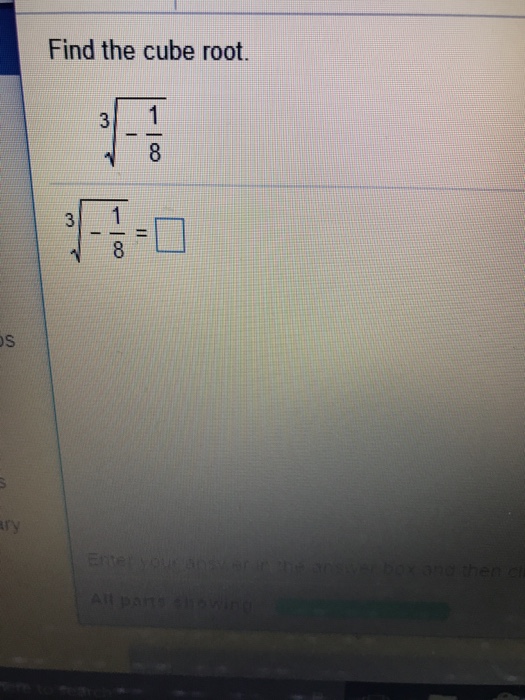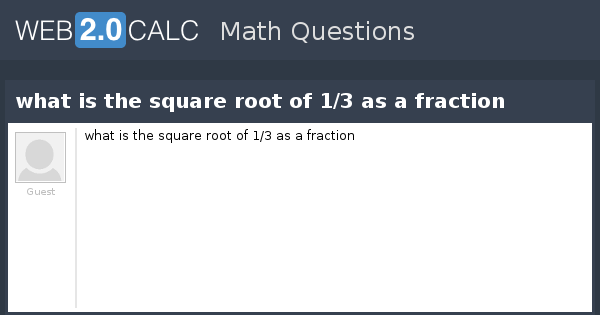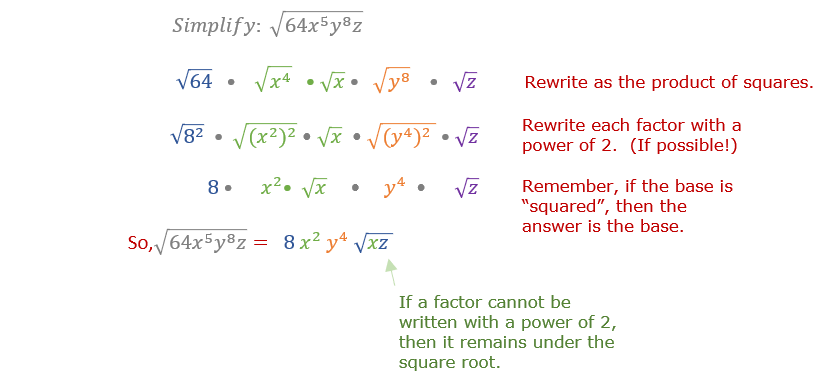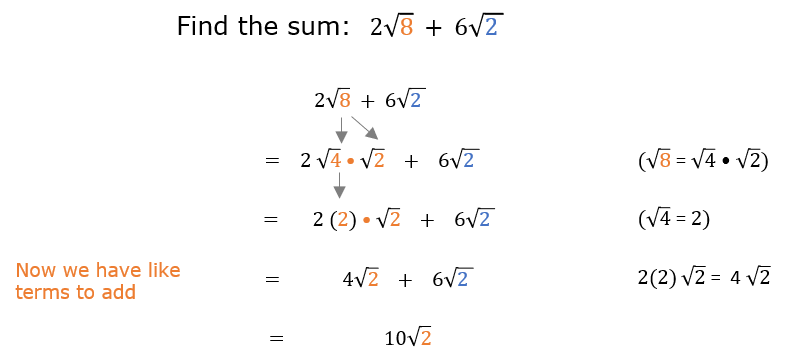Topic square root 1/8: The square root of 1/8 is an interesting mathematical concept that can be simplified and applied in various fields. This article will guide you through the simplification process, provide practical examples, and explore its significance in mathematics. Whether you're a student or a math enthusiast, understanding this topic will enhance your problem-solving skills.
Table of Content
Simplifying the Square Root of 1/8
To simplify the square root of \(\frac{1}{8}\), follow these steps:
- Rewrite the expression using the property of square roots: \(\sqrt{\frac{1}{8}} = \frac{\sqrt{1}}{\sqrt{8}}\)
- Simplify the numerator and the denominator separately: \(\sqrt{1} = 1\) and \(\sqrt{8} = \sqrt{4 \cdot 2} = \sqrt{4} \cdot \sqrt{2} = 2\sqrt{2}\)
- Combine the simplified forms: \(\frac{1}{2\sqrt{2}}\)
- Rationalize the denominator by multiplying the numerator and the denominator by \(\sqrt{2}\): \(\frac{1 \cdot \sqrt{2}}{2\sqrt{2} \cdot \sqrt{2}} = \frac{\sqrt{2}}{4}\)
Thus, the simplified form of \(\sqrt{\frac{1}{8}}\) is \(\frac{\sqrt{2}}{4}\).
Examples and Usage
Here are some examples of how this simplification might be used:
- In solving algebraic equations involving square roots
- In mathematical problems requiring simplification of fractions under a square root
For more information, you can visit the following resources:

READ MORE:
Introduction
The square root of 1/8, denoted as \(\sqrt{\frac{1}{8}}\), is a mathematical expression that simplifies into a more understandable form. To comprehend this, it involves applying properties of radicals and simplifying fractions under a square root. This concept is fundamental in algebra and helps in solving various mathematical problems. In this section, we will break down the steps to simplify \(\sqrt{\frac{1}{8}}\) in a detailed and systematic manner.
Understanding Square Roots
The concept of square roots is fundamental in mathematics. A square root of a number is a value that, when multiplied by itself, gives the original number. For instance, the square root of 9 is 3, because 3 x 3 = 9. In mathematical notation, the square root of a number 'x' is represented as √x.
When dealing with fractions, the principle remains the same. To find the square root of a fraction, you take the square root of the numerator and the square root of the denominator separately. For example, to find the square root of 1/8, you can follow these steps:
- Express the fraction under the square root: \( \sqrt{\frac{1}{8}} \).
- Separate the square roots of the numerator and the denominator: \( \frac{\sqrt{1}}{\sqrt{8}} \).
- Simplify the square roots: \( \frac{1}{\sqrt{8}} \).
- Rationalize the denominator: \( \frac{1}{\sqrt{8}} \times \frac{\sqrt{8}}{\sqrt{8}} = \frac{\sqrt{8}}{8} \).
- Simplify further if possible: \( \frac{\sqrt{8}}{8} = \frac{2\sqrt{2}}{8} = \frac{\sqrt{2}}{4} \).
This method illustrates how you can simplify the square root of a fraction, ensuring the result is in its simplest form. Understanding and mastering these steps are crucial for more complex mathematical problems involving square roots and fractions.
Square Root of Fractions
The square root of fractions can initially seem complex, but by breaking down the process step-by-step, it becomes manageable. Let’s explore how to find the square root of a fraction, using 1/8 as our example.
-
Express the Fraction: Start with the given fraction, 1/8. This fraction represents the division of 1 by 8.
-
Apply the Square Root: Use the property of square roots, which states that the square root of a fraction is the square root of the numerator divided by the square root of the denominator:
$$\sqrt{\frac{1}{8}} = \frac{\sqrt{1}}{\sqrt{8}}$$
-
Simplify the Numerator: The square root of 1 is simply 1:
$$\frac{1}{\sqrt{8}}$$
-
Simplify the Denominator: Simplify the square root of 8 by breaking it into prime factors:
$$\sqrt{8} = \sqrt{4 \times 2} = \sqrt{4} \times \sqrt{2} = 2\sqrt{2}$$
-
Combine the Results: Substitute the simplified denominator back into the fraction:
$$\frac{1}{2\sqrt{2}}$$
-
Rationalize the Denominator: Multiply the numerator and the denominator by \( \sqrt{2} \) to eliminate the square root from the denominator:
$$\frac{1 \times \sqrt{2}}{2\sqrt{2} \times \sqrt{2}} = \frac{\sqrt{2}}{4}$$
Therefore, the simplified form of the square root of 1/8 is:
$$\sqrt{\frac{1}{8}} = \frac{\sqrt{2}}{4}$$
Understanding how to simplify square roots of fractions is a fundamental mathematical skill. It involves expressing the fraction in a form that allows for easy manipulation of the square roots, simplifying each component, and ensuring the final expression is as simple as possible.
Calculation Steps for √(1/8)
To calculate the square root of the fraction 1/8, follow these detailed steps:
- Rewrite the square root of a fraction as the fraction of square roots:
\[ \sqrt{\frac{1}{8}} = \frac{\sqrt{1}}{\sqrt{8}} \]
- Simplify the square root of the numerator:
\[ \sqrt{1} = 1 \]
- Rewrite the square root of the denominator:
\[ \sqrt{8} = \sqrt{4 \times 2} = \sqrt{4} \times \sqrt{2} = 2\sqrt{2} \]
- Combine the simplified numerator and denominator:
\[ \frac{1}{\sqrt{8}} = \frac{1}{2\sqrt{2}} \]
- Rationalize the denominator by multiplying the numerator and the denominator by \(\sqrt{2}\):
\[ \frac{1}{2\sqrt{2}} \times \frac{\sqrt{2}}{\sqrt{2}} = \frac{\sqrt{2}}{2 \times 2} = \frac{\sqrt{2}}{4} \]
- The simplified form of the square root of 1/8 is:
\[ \sqrt{\frac{1}{8}} = \frac{\sqrt{2}}{4} \]
Through these steps, we find that the square root of 1/8 can be simplified to \(\frac{\sqrt{2}}{4}\), which is the most reduced form.

Simplifying the Expression
To simplify the square root of , we follow a series of steps:
- Rewrite the expression using the property of square roots: .
- Since the square root of 1 is 1, the expression becomes: .
- Simplify . Since 8 can be factored into 4 and 2, and 4 is a perfect square, we get: .
- Substitute this back into the fraction: .
- Rationalize the denominator by multiplying the numerator and the denominator by : .
Thus, the simplified form of the square root of is .
Rationalizing the Denominator
Rationalizing the denominator involves eliminating any irrational components, such as square roots, from the denominator of a fraction. This process simplifies the fraction, making it easier to handle in further mathematical operations.
To rationalize the denominator of
Identify the irrational component in the denominator. Here, it is
Multiply both the numerator and the denominator by the same irrational component to eliminate the square root in the denominator:
Simplify the resulting fraction. The numerator becomes and the denominator simplifies to .
Reduce the fraction to its simplest form:
The rationalized and simplified form of
Exact and Decimal Forms
To understand the exact and decimal forms of the square root of \( \frac{1}{8} \), we will go through the step-by-step process of simplifying and converting the expression.
Exact Form
The exact form of the square root of \( \frac{1}{8} \) can be determined by simplifying the radical expression:
- Start with the expression: \[ \sqrt{\frac{1}{8}} \]
- Use the property of square roots that states \( \sqrt{\frac{a}{b}} = \frac{\sqrt{a}}{\sqrt{b}} \): \[ \sqrt{\frac{1}{8}} = \frac{\sqrt{1}}{\sqrt{8}} \]
- Simplify \( \sqrt{1} \) and \( \sqrt{8} \): \[ \frac{\sqrt{1}}{\sqrt{8}} = \frac{1}{\sqrt{8}} \]
- Rationalize the denominator by multiplying the numerator and denominator by \( \sqrt{8} \): \[ \frac{1}{\sqrt{8}} \times \frac{\sqrt{8}}{\sqrt{8}} = \frac{\sqrt{8}}{8} \]
- Since \( \sqrt{8} = \sqrt{4 \times 2} = 2\sqrt{2} \), the expression becomes: \[ \frac{2\sqrt{2}}{8} = \frac{\sqrt{2}}{4} \]
Therefore, the exact form of the square root of \( \frac{1}{8} \) is:
\[ \frac{\sqrt{2}}{4} \]
Decimal Form
The decimal form can be obtained by evaluating the square root of 1/8 numerically:
- Calculate the square root of 1/8 using a calculator: \[ \sqrt{\frac{1}{8}} \approx 0.353553 \]
- Alternatively, calculate it by finding the decimal form of \( \frac{\sqrt{2}}{4} \): \[ \frac{\sqrt{2}}{4} \approx \frac{1.414213}{4} \approx 0.353553 \]
Thus, the decimal form of \( \sqrt{\frac{1}{8}} \) is approximately 0.353553.
Applications and Examples
The square root of \( \frac{1}{8} \) is not just a mathematical abstraction; it has practical applications in various fields. Below, we explore several examples and contexts where understanding and using \( \sqrt{\frac{1}{8}} \) can be beneficial.
1. Geometry and Trigonometry
Square roots often appear in geometry, particularly when dealing with right triangles. The Pythagorean Theorem, for instance, requires calculating square roots to find the length of sides. Suppose we have a triangle where the hypotenuse \( c \) and one leg \( a \) are known, and we need to find the other leg \( b \). The formula is:
\[ a^2 + b^2 = c^2 \]
Rearranging to solve for \( b \) gives:
\[ b = \sqrt{c^2 - a^2} \]
In some cases, the value under the square root could be \( \frac{1}{8} \), making the use of \( \sqrt{\frac{1}{8}} \) necessary for exact measurements.
2. Physics and Engineering
In physics, square roots are crucial when solving equations involving energy, waves, and other phenomena. For instance, the calculation of root mean square (RMS) values of alternating current (AC) circuits often involves square roots. If an engineer encounters a scenario where a specific dimension or value under a square root simplifies to \( \frac{1}{8} \), knowing \( \sqrt{\frac{1}{8}} \) aids in precise calculations.
3. Computer Graphics and Game Development
Square roots are used in computer graphics to calculate distances between points in 2D or 3D space. The distance formula between two points \((x_1, y_1)\) and \((x_2, y_2)\) is:
\[ D = \sqrt{(x_2 - x_1)^2 + (y_2 - y_1)^2} \]
In scenarios where the terms within the square root reduce to \( \frac{1}{8} \), understanding how to handle \( \sqrt{\frac{1}{8}} \) ensures accurate rendering of images and animations.
4. Financial Modeling
Square roots appear in financial formulas, such as those for calculating standard deviation or other risk metrics in portfolio management. For example, if part of a variance calculation simplifies to \( \frac{1}{8} \), using \( \sqrt{\frac{1}{8}} \) helps determine precise risk values for investments.
Examples
- Geometry: Finding the diagonal length of a rectangle with sides 1 and \( \frac{1}{4} \) requires calculating \( \sqrt{1 + \left(\frac{1}{4}\right)^2} = \sqrt{1 + \frac{1}{16}} = \sqrt{\frac{17}{16}} = \frac{\sqrt{17}}{4} \).
- Physics: In wave mechanics, determining the RMS value of a wave with an amplitude function involving \( \frac{1}{8} \).
- Computer Graphics: Calculating the precise distance between two points where coordinates are such that the terms involve \( \frac{1}{8} \).
- Finance: Modeling the fluctuation of stock prices where the variance includes a term of \( \frac{1}{8} \).

Common Mistakes to Avoid
When calculating the square root of
- Misunderstanding the Property of Square Roots: Remember that the square root of a fraction
a b a b a b - Incorrect Simplification: It's essential to simplify the expression correctly. For example,
1 8 1 8 1 2 2 - Neglecting to Rationalize the Denominator: Failing to rationalize the denominator can leave your answer in an unconventional form. The expression
1 2 2 2 4 - Incorrect Decimal Conversion: When converting to a decimal, ensure that you use enough decimal places for precision. The square root of
1 8 - Arithmetic Errors: Simple arithmetic errors can lead to incorrect results. Double-check each step of your calculation, especially when multiplying or dividing square roots.
By being aware of these common mistakes, you can improve the accuracy and reliability of your calculations involving the square root of
Advanced Concepts
Diving deeper into the square root of
- Radical Expressions and Their Properties:
Radical expressions often involve roots of numbers. The square root of
1 8 1 8 1 8 1 8 - Simplification Using Prime Factorization:
Simplifying the square root of
8 8 =2 3 2 8 2 3 2 2 2 Thus,
1 8 1 2 2 - Rationalizing the Denominator:
It’s often preferred to express fractions without a radical in the denominator. To rationalize
1 2 2 2 1 2 2 2 2 2 4 - Exponential Form:
Square roots can also be expressed using exponents. The square root of
1 8 1 8 1 2 1 8 1 2 8 1 2 1 2 2 - Applications in Higher Mathematics:
Understanding the square root of fractions is essential in calculus, particularly when dealing with limits, derivatives, and integrals involving radical expressions. This concept also plays a critical role in solving differential equations where such expressions frequently appear.
By mastering these advanced concepts, you can handle more complex mathematical problems and appreciate the deeper structure of numbers and their relationships.
Những Căn Bậc Hai và Căn Bậc Ba | Toán học với Thầy J
READ MORE:
Đơn Giản Một Phân Số Dưới Dấu Căn - Bí Quyết Toán Học










